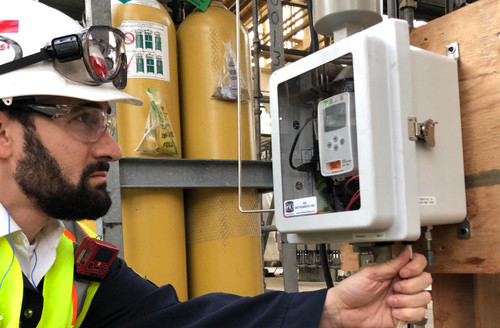Frequently Asked Questions about LEL Gas and LEL Gas Detectors
Understanding the lower explosive limits (LEL) of combustible gases is crucial when it comes to protecting the health and safety of your employees. As a construction worker, maintenance professional or someone that works in confined spaces, you need to be aware of the LELs of certain hazardous gases, while measuring the amount of gas in the air as a percentage of the total volume using a gas monitor. If the amount of gas in the air suprasses the LEL, the gas could spontaneously combust, injuring your team in the process.
If you are unfamiliar with the LELs of various hazardous gases and how they can affect your workplace, learn more about this important concept and how you can protect your team from potential hazards on the job.
What is the LEL of a gas?
The term L.E.L. stands for Lower explosive limit of a combustible gas or vapor. It’s the lowest level a gas can ignite in air in the presence of an ignition source. Conversely, U.E.L (upper explosive limit) is the maximum level in air that a gas may ignite. Any amount of gas below the LEL, or above the UEL will not combust due to it being too lean or too rich. For the time being we’ll concern ourselves with just LEL.
How is LEL measured?
Known combustible gasses have a determined LEL expressed as a volume %Vol. As the amount of detectable combustible gas rises, an LEL sensor will display a readout from 0 - 100% LEL. For example: Methane has an LEL of 5.0% Vol in air. When the volume of Methane has reached 2.5% Vol, we've reached the 1/2 way point or 50% LEL. If volume continues to rise to 5.0% Vol, the gas monitor will display 100% LEL and combustion is imminent if conditions are right. An easy way to discern %Vol and %LEL is that the former is essentially a measurement of "how much in air" and the latter is an assessment of “how dangerous."
What is a safe LEL level?
Factory default alarms are typically set very conservatively: Low 10%, High 20%. It's important to understand that conditions can change suddenly, and that the LEL sensor isn't able to discern what specific gas (or combination of gasses) is being measured. For example: If an LEL sensor is calibrated with Methane gas, but the target gas is known to be pentane which has a lower LEL of 1.8% Vol, then actual %LEL could be double. Gas monitor displays 50%LEL, but is actually closer to 100%LEL due to it being a different target gas. Manufacturers do have published charts detailing correction factors to adjust readout for specific gasses. As a rule of thumb, alarm set points should be set conservatively to allow for inaccuracies and unknown conditions.
How do LEL sensors work?
The most common LEL sensor you may encounter is known as a Catalytic Bead Combustible sensor. It detects gas through a process of catalytic oxidation. In layman terms, the heart of a catalytic bead sensor is the wheatstone bridge circuit formed by the two catalytic beads. One is used as a reference and the other is active. Voltage is applied to this active bead which heats it up to a point that readily sustains combustion. As detectable gas is introduced, the active bead heats up even more causing a measurable change in electrical resistance. This linear response becomes the LEL% reading on your meter.
What are the best LEL gas monitors?
There isn't necessarily a "best" gas monitor, rather consider selecting a monitor suitable for your application and budget. For most general contracting and compliance needs, any of our 4 Gas detectors (pumped or diffusion) like our BW’s GasAlertMax XT II or RKI’s GX-3R will be fine. If you work with varying combustibles consider a ToxiRaePro LEL. This unit has a built in selectable library of correction factors to choose from. More specialized gas monitors like RKI’s GX2012 will allow for more advanced tasks such as leak investigation (in PPM Levels) or purge testing (0-100% Vol). Again, ultimately it depends on your application and budget.
Use this information to protect your team from hazardous gases on the job. Trace amounts of some gases may be in the air around your worksite without you realizing it, so you need to use a gas monitor whenever possible. Program the monitor so that the alarm will go off before the target gas reaches the LEL to reduce your risk. If you need help installing your gas monitor in the workplace, come to PK Safety for gas detector calibration services. We will help you calibrate and program your monitor for your target gas, so you can use this equipment with more peace of mind.
Looking for a LEL gas monitor? We carry single and multi-gas monitors that detect LEL gases.
Featured searches
Portable LEL Gas Detector, 4 Gas Monitor, Catalytic Gas Detector
Recent Posts
-
Promoting Safety: National Work Zone Awareness Week is April 15-19, 2024
Each year, the National Work Zone Awareness Week (NWZAW) places the spotlight on the importance o …Apr 11th 2024 -
Understanding 4 Gas Monitors: How They Work & Why They Are Important
In today’s increasingly dynamic industrial landscape, 4 gas monitors have emerged as critical com …Apr 8th 2024 -
April Showers Require Workers to Wear Hi-Vis Safety Rain Gear
While April showers bring May flowers, they also bring challenges, particularly for those working …Apr 1st 2024





